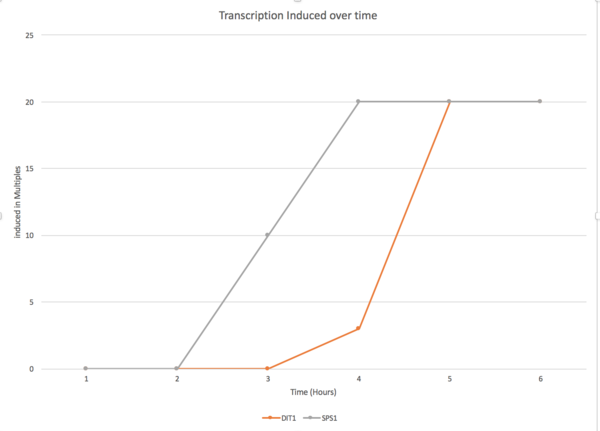Difference between revisions of "Zvanysse Week 6"
m (updated graph) |
(answering and tweaking questions) |
||
| Line 22: | Line 22: | ||
Yes, genes X and Y were transcribed similarly. They both have a spike in transcriptions and then quickly fall nearing 0 by the end of hour 9. | Yes, genes X and Y were transcribed similarly. They both have a spike in transcriptions and then quickly fall nearing 0 by the end of hour 9. | ||
===Question 4=== | ===Question 4=== | ||
| + | The yellow indicates a 1:1 ratio of the green and red cDNAs. When red and green pigmentation are combined, it makes yellow. Biologically speaking, the means that the open reading frame for the gene is transcribed in the presence and absence of oxygen. Usually in the beginning time points, a gene is able to be transcribed in both environments which explains the abundance of yellow dots. This will of course change as time goes on and the environment changes. | ||
===Question 5=== | ===Question 5=== | ||
| − | According to OD 3.7 in Figure 4.12, TEF4 is depicted as repressed. This is possibly because TEF4 needs glucose to be able to transcribe, so as glucose supplies are reduced, the TEF4 gene's ability to transcribe reduce as well. It is shown in figure 4.10 that as glucose levels drop, cell density increases. | + | According to OD 3.7 in Figure 4.12, TEF4 is depicted as repressed. This is possibly because TEF4 needs glucose to be able to transcribe, so as glucose supplies are reduced, the TEF4 gene's ability to transcribe reduce as well, as it must save it's energy. It is shown in figure 4.10 that as glucose levels drop, cell density increases. |
===Question 6=== | ===Question 6=== | ||
| + | As glucose supplies run out, more molecules enter into the TCA cycle due to the increased production of acetyl-CoA (the primary molecule that enters into the TCA Cycle) from alcohol dehydrogenase. As these molecules enter into the TCA cycle, an induction is demanded to be able and take care of the new influx of molecules. | ||
===Question 7=== | ===Question 7=== | ||
| − | + | If all the genes for enzymes in a common pathway are regulated by a similar transcription factor, the genome is able to ensure induction or repression simultaneously. | |
===Question 8=== | ===Question 8=== | ||
| + | |||
===Question 9=== | ===Question 9=== | ||
Assuming that cells that over express the transcription factor of Yap1p were subjected to the same experiment of a timecourse of glucose depletion, the spots that represented Yap1p target genes would show up as green the later the time points of this experiment. This is because Yap1p confers environmental stress. I am assuming that glucose depletion is an environmental stress factor. | Assuming that cells that over express the transcription factor of Yap1p were subjected to the same experiment of a timecourse of glucose depletion, the spots that represented Yap1p target genes would show up as green the later the time points of this experiment. This is because Yap1p confers environmental stress. I am assuming that glucose depletion is an environmental stress factor. | ||
===Question 10=== | ===Question 10=== | ||
Revision as of 18:50, 9 October 2017
Contents
Biological Databases Bookwork
Question 1
Question 2
Gene X
- Hour 1: 1.0 ratio, black.
- Hour 3: 2.2 ratio, very dim red.
- Hour 5: 1.0 ratio, black.
- Hour 9: 0.15 ratio, medium green.
Gene Y
- Hour 1: 1.0 ratio, black.
- Hour 3: 4.5 ratio, dim red.
- Hour 5: 0.95 ratio, still black.
- Hour 9: 0.05 ratio, very bright green.
Gene Z
- Hour 1: 1.0 ratio, black.
- Hour 3: 1.5 ratio, very dim red.
- Hour 5: 2.0 ratio, very dim red.
- Hour 9: 2.0 ratio, very dim red.
Question 3
Yes, genes X and Y were transcribed similarly. They both have a spike in transcriptions and then quickly fall nearing 0 by the end of hour 9.
Question 4
The yellow indicates a 1:1 ratio of the green and red cDNAs. When red and green pigmentation are combined, it makes yellow. Biologically speaking, the means that the open reading frame for the gene is transcribed in the presence and absence of oxygen. Usually in the beginning time points, a gene is able to be transcribed in both environments which explains the abundance of yellow dots. This will of course change as time goes on and the environment changes.
Question 5
According to OD 3.7 in Figure 4.12, TEF4 is depicted as repressed. This is possibly because TEF4 needs glucose to be able to transcribe, so as glucose supplies are reduced, the TEF4 gene's ability to transcribe reduce as well, as it must save it's energy. It is shown in figure 4.10 that as glucose levels drop, cell density increases.
Question 6
As glucose supplies run out, more molecules enter into the TCA cycle due to the increased production of acetyl-CoA (the primary molecule that enters into the TCA Cycle) from alcohol dehydrogenase. As these molecules enter into the TCA cycle, an induction is demanded to be able and take care of the new influx of molecules.
Question 7
If all the genes for enzymes in a common pathway are regulated by a similar transcription factor, the genome is able to ensure induction or repression simultaneously.
Question 8
Question 9
Assuming that cells that over express the transcription factor of Yap1p were subjected to the same experiment of a timecourse of glucose depletion, the spots that represented Yap1p target genes would show up as green the later the time points of this experiment. This is because Yap1p confers environmental stress. I am assuming that glucose depletion is an environmental stress factor.
